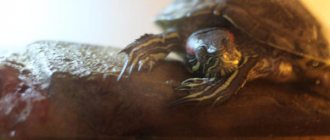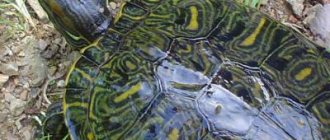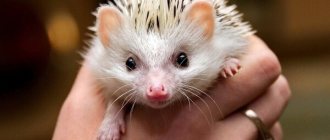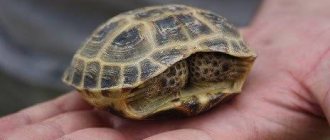There are several different species of red-eared turtles, which vary in size. They are not difficult to keep at home, but some species require organization of sleep and in this regard, the owners have a number of questions:
- Does a red-eared turtle need hibernation if it is not in natural conditions?
- Why do they hibernate?
- What needs to be done to prevent the turtle from falling asleep?
- What is the function of hibernation for turtles?
- What is the red-eared slider's sleep period?
Duration and causes of hibernation in the wild
Aquatic turtles hibernate (winter) when temperatures are too low, falling below 15° and remaining at this level for a long time. The reptile goes underground and sleeps until the temperature rises in a dug hole.
IMPORTANT! Marine and freshwater turtles usually bury themselves in sand or mud to protect themselves from ice build-up. When living in warmer conditions, there is no need for wintering, but too high a temperature can cause summer hibernation.
Red-eared turtles hibernate when winter arrives and do not emerge from it until early spring. Their sleep lasts from 4 to 6 months and depends on the size of the reptile. The smaller the turtle, the more time it needs to sleep.
What to do if the turtle falls asleep
Before hibernation, the turtle must eat well
Ideally, the turtle's body should be adequately prepared for hibernation. Because,
Before hibernation, the turtle should stop feeding, but not stop giving it water, give it a final bath (immersion in water) and then put it to sleep in a pre-prepared box. If you did not have time to do all this, however, you are sure that the animal will be able to survive the winter, you will need to place the sleeping turtle in a box, which you previously lined with peat or moss. During the winter, the inside surface of the box will need to be moistened. At the same time, in order for the turtle to sleep soundly and not be tormented by nightmares, during the first 2 weeks of its hibernation, you will have to reduce the temperature in the room where the box is located to 6-10 degrees above zero.
If you think that the turtle is not ready to sleep, then it is better to wake it up as quickly as possible.
Features of hibernation in domestic turtles
Red-eared turtles living at home hibernate only in rare cases. This condition is observed in single individuals or is achieved artificially due to manipulations by the owner.
Turtles hibernate at low temperatures, so comfortable housing conditions that maintain optimal temperatures eliminate this need. Due to the reduction in daylight hours in winter, reptiles sleep more than usual, but do not lose activity.
IMPORTANT! A wild turtle brought into the house shortly before falling asleep can go into hibernation. In this case, the animal does not have time to adapt to new living conditions.
If you try to lull a turtle at home, you may encounter the following problems:
- Deviation of humidity and temperature indicators. Too low levels can lead to the death of the pet.
- Penetration of insects. Intruders entering the wintering area can damage the sleeping turtle.
- Deterioration of condition. Hibernation takes a lot of resources from the body, so sick animals run the risk of complications.
Description of the species
Red-eared turtles in nature reach 30 cm in length (based on the shell), but when kept at home they rarely grow to that size. Females are significantly larger than males. The shell of juveniles is bright green, but as the turtle matures it becomes brown or olive in color with patterns of bright yellow stripes.
The head, neck and paws of the animal are decorated with a series of white and black stripes. The species got its name due to the bright red spots near the eyes. These “ears” can also be deep orange or rich yellow. It is thanks to its bright appearance that the red-eared turtle has become one of the most popular exotic pets.
She prefers to lead a sedentary lifestyle, but swims very quickly in the water and is extremely curious. May hiss and snort, expressing his displeasure and anxiety. When defending its life, it can inflict serious wounds with the sharp claws of its hind legs. In the cold season, a phenomenon called suspended animation, or hibernation, occurs for red-eared turtles.
Signs of hibernation
The state of wintering is often confused with death. To put your mind at ease, check your red-eared slider for several points that will help you understand that it is definitely hibernating:
- Jaws. Try to pull your lower jaw down and leave your mouth open. The reptile should try to close its jaws.
- Eyes. A cold metal spoon placed against your pet's eye should trigger the corneal reflex. If the turtle tries to retract the disturbed organ or opens its eyelids, then there is no reason to worry.
- Reaction to heat. A hibernating red-eared turtle placed in a container of warm water (30°C) will begin to move its paws.
Otherwise, signs of hibernation include:
- Decreased activity. The pet behaves lethargically, hides in a corner of the aquarium, remaining motionless, and refuses to leave its house for a walk.
- Poor appetite. In addition to loss of activity, the reptile refuses its favorite food and reduces its usual amount of food.
- Increased sleep duration. Long periods of rest are accompanied by frequent yawning.
Pleasant awakening
Coming out of hibernation is an important moment in the life of a turtle, and it needs help to cope with this task. How to bring a turtle out of hibernation? All autumn reserves are used up, the turtle wakes up weak, exhausted and vulnerable to infections. At this moment, she needs care and quality nutrition more than ever.
After the turtle comes out of hibernation, it is warmed with a lamp or fan heater, then a “bath day” is arranged - in a small container with warm water. The turtle should bathe for about 10 minutes, this will restore the water balance in its body.
After hibernation, water procedures must be repeated every day for a week. They can be stopped when the reptile urinates for the first time. At first, her urine will be thick and dark yellow, but gradually the toxins will come out and it will become light in color again.
Now you can “sit down at the table,” of course, if its appetite has awakened along with the turtle. At first, the reptile may refuse food, this is normal, gradually everything will recover.
What signs can be used to determine that a turtle has safely emerged from hibernation? A healthy reptile's tongue will be pink or orange, without a coating. If it is bright red, the animal may be infected with something. The eyes should be clear and clean, also without plaque or discharge.
Hibernation is a completely natural process for turtles living in nature, but for indoor pets, wintering is often not relevant. This is a rather complicated procedure and a huge burden on the turtle’s body, so it is not recommended to hibernate turtles on your own, only under the supervision of a specialist.
The first signs that it is time for the animal to winter can be observed in late October - early November. The turtle becomes less active, its appetite decreases, it tries to bury itself in the ground or almost never leaves its shelter. In the natural environment, hibernation lasts from 3 to 5 months, all vital processes of the body slow down, and accumulated resources are used to maintain life. There are also advantages to wintering: it is indicated for turtles from which the owners plan to get offspring, since hormonal levels are adjusted, life expectancy increases, and the activity of the internal glands is maintained.
It is worth remembering that under artificial conditions hibernation should not be so long: for small breeds it is 8-10 weeks, for large breeds it is 12-14. The animal must be absolutely healthy, and a suitable microclimate must be maintained constantly, otherwise the turtle may not emerge from hibernation. If you are not confident in your abilities, it is easier to maintain normal conditions: temperature at 27-28 degrees, frequent bathing, good nutrition. Does your turtle eat well? – go to the clinic, a specialist will give her an injection of vitamins.
Rules for caring for a sleeping turtle
If you notice the first signs of the approaching winter in a red-eared slider, be sure to consult with a veterinarian, who will examine it and tell you what needs to be done if the reptile actually hibernates.
During the winter, adhere to the following recommendations:
- Lower the water level. The turtle burrows into the ground, where it can sleep for a long time without rising to the surface. Oxygen is obtained by special membranes in the cloaca and oral cavity.
- Turn off additional lighting. The pet will have to go to the bottom to maintain warmth, so turn off the filtration and monitor the water level. Excessive movement will destroy the thermal layer, and a low water level will lead to freezing to the very bottom.
- Avoid feeding. Thanks to slow digestion, the turtle digests the food eaten the day before over the course of several months.
- Monitor your pet's well-being. Domestic turtles fall asleep as early as November, when daylight hours begin to shorten, and sleep for about 4 months. It happens that the reptile does not wake up even in February. In this case, you have to wake up the pet yourself.
If the turtle looks active or it is February, then gradually increase the temperature and light to normal. The recovery period takes from 5 to 7 days.
You can feed your pet only after returning to normal activity, but not earlier than the 5th day.
IMPORTANT! After winter is over, take your pet to a veterinary clinic for an examination. The doctor will identify possible complications and prescribe timely treatment if necessary.
Both laughter and sin: what you definitely shouldn’t do with a turtle
Photo: still from the movie “Teenage Mutant Ninja Turtles”
Under natural conditions, representatives of some species can live more than 150 years. In this regard, turtles are ahead of all vertebrates. The famous Madagascan Tui Malila was included in the Guinness Book of Records for her longevity - at the time of her death she was more than 190 years old. In captivity, medium-sized turtles live up to 30–60 years, but large ones can live up to 150. Experts attribute their longevity to a slow metabolism, like all cold-blooded turtles.
However, acquaintance with humanity is not always favorable for turtles. In the 18th century, turtles served as live canned food for sailors. The author of the work “Animal Life”, German zoologist Alfred Brehm, spoke about the relationship of sailors with turtles as follows:
“Captured turtles are usually turned over on their backs. There is no ceremony with them: they are simply put aside somewhere on the deck, a sail is stretched over them to protect them from the sun and they do not care about anything else, relying on their survivability. They are not given any food or drink.”
Today, turtle meat is used to make soup and stew, and the shell is used for decorative items and other trinkets.
Psychologist: where do people become cruel to animals?
Cruelty towards animals speaks of internal aggression. In fact, it has always been there: before in villages, if neighbors were arguing, one of them could calmly go and shoot the dog - however, in essence this is aggression towards the neighbor, and not towards the dog itself. In such cases, people simply project their anger onto animals.
Almost all animals depend on us, many of them get used to us - in this sense, a person acts as a manipulator, and some people enjoy the feeling of power over a weaker creature.
Personally, I am convinced that a person can be dangerous if he kills an animal not for the sake of eating it. Any living creature has a serious barrier to killing just like that. If a person shows unreasonable aggression towards animals, who knows what he might be capable of towards people.
Natalya Panfilova psychologist
Neighborhood with people is sometimes fraught with unintentional killing of turtles: accidentally crushing an animal under a sofa or dropping it from a height of human height is quite a classic outcome for this type of pet. The m24.ru correspondent has heard enough about various horrors and decided to introduce you to the most ridiculous of them.
Top 5 most ridiculous accidental deaths of pet turtles:
- Fifth place: eaten by a dog or cat. Not all pets can live under one roof. Cases of turtles being eaten or torn apart by dogs or cats are quite common. There are owners who manage to teach such diverse pets to live in peace and harmony, but this does not always happen;
- Fourth place: put it in the refrigerator. Maslova was not the only one who accidentally froze the poor animal. Knowledge about the wintering of turtles is widespread among lovers of these reptiles, but not everyone can use it correctly;
- Third place: a land turtle choked in a cup of cola. The owner simply decided to quench his pet's thirst by placing him upside down in a full cup;
- Second place: took it and dried it. One of the respondents told how he put a turtle on a radiator to make it warmer. Good intentions led the poor thing to hell - she turned into a mummy. Some experts associate such consequences with dehydration of the body and possible diseases, others argue that under or on the radiator the turtle simply overheats and dies, and drying out as such occurs after death;
- First place: unintentional soup. One guy really loved his turtle, which often sat on his shoulder. He also loved dumplings. While preparing the next broth, the turtle was just sitting on his shoulder, and suddenly he fell straight into the boiling water. She was boiled. Dinner did not take place.
The feasibility of artificial hibernation and preparation rules
The hibernation state has a positive effect on the reproductive system of reptiles, so experienced breeders send their pets into hibernation on their own.
IMPORTANT! If you have insufficient experience and there is no good reason, it is not recommended to hibernate a turtle, since caring for it at home is very problematic.
Preparing for hibernation includes the following steps:
- Increasing the size of the diet 2 months before falling asleep. During the winter, turtles do not eat and lose almost half of their weight. Without a layer of fat, a supply of nutrients and vitamins, the animal may die.
- Canceling feeding 1 week before wintering. Additionally, the water level decreases.
- Smooth decrease in temperature over 10 days. Turtles are lethargic at temperatures below 15°, and at temperatures below 10° they go into hibernation.
- Gradual reduction of daylight hours over 10 days. Reduce lamp operating hours, turn off filters and increase room humidity.
- Bathe your reptile on the last day before wintering. A warm water bath will help you relax and empty your bowels.
IMPORTANT! Check the sleeping turtle every 3 days and spray the soil with water to maintain moisture.
Remember that during hibernation it is prohibited:
- wake up and put your pet back to sleep;
- awaken the reptile before daylight hours increase;
- carry out bathing, which triggers the process of urination when the shell comes into contact with water;
- continue sleeping with a strong decrease in body weight (the animal loses more than 10% within 1 month);
- Allow long-term cooling below 0°.
In addition to the terrarium, you can use a special plastic container. Before using it you must:
- Fill 10-30 cm with substrate (peat, sand, moss, sphagnum), dry leaves or decorative pieces of bark. The selected container should be well ventilated, and the substrate should remain dry even at high humidity.
- Cool on the balcony, in the basement or in the refrigerator for several days.
- Place in a cool, but draft-free place at a temperature of 6° to 10°. There is no need to warm the hibernation site, as this can provoke early awakening and disorientation of the animal.
After waking up, the turtle is bathed in warm baths to restore its usual temperature and start internal processes.
IMPORTANT! If after wintering the reptile shows lethargy and looks exhausted, then consult a veterinarian to find out the cause of the symptoms.
Not everything is so bad: when a person is a friend to a turtle
Photo: m24.ru/Alexander Avilov
In fact, a turtle can get along well with a person if you care for it properly and do not expose its life to undue risk. The press service of the Moscow Zoo told m24.ru that 16 species of turtles safely exist in their terrarium, including a huge black elephant turtle, the size of which can reach 130 centimeters and weight up to 300 kilograms.
Land turtles in the zoo are fed vegetables and fruits, while freshwater turtles are fed fish, meat, squid and insects. They keep turtles in specially equipped terrariums, providing them with all the conditions for proper habitat and reproduction.
Keeping a turtle, including at home, largely depends on its species
It is important that the home is spacious. Freshwater animals should be kept in an aquarium with water and land areas (for example, in the form of stones), a special filter to purify the water and, preferably, there should be an ultraviolet lamp above the aquarium, which helps strengthen the animal’s skeletal system
Land turtles live well in a terrarium or enclosure with soil and dry grass.
Photo: m24.ru/Lidiya Shironina
Some people love their pets so much that they constantly associate themselves with them - this is noticeable in photographs and cute statuses on social networks. Psychologist Natalya Panfilova explained to m24.ru what this widespread social phenomenon is connected with:
“The explanation is as old as the world: if we take some archaic things, our ancient ancestors often compared themselves to some animals. For example, they took speed from a cheetah, strength from a wolf, and so on. People love to take pictures with cats because many people associate a cat with the warmth of home or with independence. Man tries to associate himself with those characteristics of animals that he himself would like to possess.”
When asked what you associate turtles with, most will answer – with slowness. Therefore, we decided to find out how human slowness differs from real snail speed.
How to avoid wintering?
To prevent the turtle from hibernating, make sure that there are optimal temperature conditions for keeping it:
- Water. The temperature should be 22°-28°. Any decrease will lead to a decrease in activity and a gradual slowdown of internal processes.
- Land. The island is used by turtles for heating, so the temperature here can reach up to 32°.
The cause of hibernation can also be a lack of vitamins. Make sure there is enough ultraviolet light or get a vitamin shot at a veterinary clinic. This will prevent the turtle from hibernating due to lack of nutrients.
Due to the labor-intensive process and high risks, it is not recommended to put the reptile into hibernation. If in nature the process occurs naturally and its time is determined by biological rhythms, then at home the responsibility falls solely on the owner.
Other interesting articles
- Aquarium fish cardinal: Types, contents For everyone who has an aquarium in their home, the cardinal fish is one of the most suitable…
- Zebra fish: types and contents The aquarium fish pseudotropheus or zebra from the cichlid family naturally lives in the lake area…
- Minor fish: maintenance and care, compatibility, breeding General information Minor is an aquarium fish of the Characin family. Under natural conditions, it lives in…
Awakening
A few words about how to bring a red-eared turtle out of hibernation. If conditions are good, then the duration of hibernation is 3-5 months. You cannot feed the animal immediately after waking up; you need to wait until its digestive system starts working. Wash the animal in warm water, this will speed up the awakening process. You can't let hibernation be too long. Gradually increase the temperature of the reptile, thereby stimulating the awakening process. If you do not do this, the animal may become completely weak.
Hibernation is a completely natural process for turtles living in nature, but for indoor pets, wintering is often not relevant. This is a rather complicated procedure and a huge burden on the turtle’s body, so it is not recommended to hibernate turtles on your own, only under the supervision of a specialist.
The first signs that it is time for the animal to winter can be observed in late October - early November. The turtle becomes less active, its appetite decreases, it tries to bury itself in the ground or almost never leaves its shelter. In the natural environment, hibernation lasts from 3 to 5 months, all vital processes of the body slow down, and accumulated resources are used to maintain life. There are also advantages to wintering: it is indicated for turtles from which the owners plan to get offspring, since hormonal levels are adjusted, life expectancy increases, and the activity of the internal glands is maintained.
It is worth remembering that under artificial conditions hibernation should not be so long: for small breeds it is 8-10 weeks, for large breeds it is 12-14. The animal must be absolutely healthy, and a suitable microclimate must be maintained constantly, otherwise the turtle may not emerge from hibernation. If you are not confident in your abilities, it is easier to maintain normal conditions: temperature at 27-28 degrees, frequent bathing, good nutrition. Does your turtle eat well? – go to the clinic, a specialist will give her an injection of vitamins.










